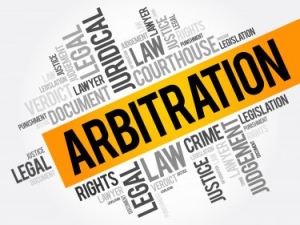
Bill MacMinn
Bill concentrates his practice in the area of litigation, including Commercial Litigation, Personal Injury, Products Liability, Employment Litigation, Estate Litigation, Real Estate, and Arbitration. He represents a broad spectrum of individuals, corporations and institutions in commercial, employment litigation, collection, construction and personal injury actions. He has expertise in a wide variety of venues in Bucks and surrounding counties, and in the United States District Court. Bill also has extensive experience in Alternate Dispute Resolution forums, including participation in the American Arbitration Association, private arbitrations and private court systems. He is frequently appointed as arbitrator.
To view Bill MacMinn's full profile, click here.
Website URL: http://www.ammlaw.com/attorney-profiles/william-t.-macminn.html
Pennsylvania’s New Arbitration Act: What Non-Litigators Should Know
On July 1, 2019 arbitration agreements in Pennsylvania will be governed by the Revised Uniform Arbitration Act (RUAA). RUAA revises the Uniform Arbitration Act which has been in force in Pennsylvania since 1980. What should non-litigators know about RUAA?
1. Application
RUAA applies on a mandatory basis to all agreements to arbitrate signed after July 1, 2019. In addition, the parties to an arbitration agreement executed before July 1, 2019 can agree that RUAA’s provisions govern.
2. Common Law Arbitration
Since 1980, Pennsylvania has had in effect two options for arbitration. Parties could specify that their arbitration was governed by the terms of RUAA’s predecessor, the Uniform Arbitration Act. If they did not do so, governance of the arbitration defaulted to common law arbitration rules. Both the Uniform Arbitration Act and common law arbitration (despite its name) were codified in Pennsylvania’s Judicial Code. RUAA abolishes common law arbitration in Pennsylvania.
3. Impartiality of Arbitrators
RUAA includes disclosure requirements not previously found in the law. Under RUAA an arbitrator must make a reasonable inquiry to determine the existence of any facts which a reasonable person would consider likely to affect an arbitrator’s impartiality. These include a personal or financial interest in the outcome of the case, past or present relationships with the parties, their attorneys or representatives, witnesses or other appointed arbitrators. Disclosure of any such facts must be made. Failure to do so may constitute grounds to vacate any award. To preserve the right to claim partiality after disclosure, timely objection must be made and if the arbitration agreement or rules of the arbitration organization provide rules to challenge the appointment, such rules must be followed.
4. Immunity of Arbitrators
Arbitrators are afforded immunity under RUAA to the same extent that a judge, sitting in a civil action would be immune.
5. Consolidation
RUAA provides that under certain circumstances a court may order consolidation of multiple pending arbitration matters, unless the agreement prohibits such consolidation.
6. Interim Remedies
Before an arbitrator is appointed, RUAA permits the Court to enter a provisional or interim order to protect the effectiveness of the arbitration proceeding. Once appointed, an arbitrator can modify the Court’s provisional order or enter a provisional order his own. Such orders include temporary restraining orders as well as the issuance of liens and preliminary injunctions.
7. Discovery
Before RUAA, there was no guidance on the conduct of discovery other than the power granted to the arbitrator to issue subpoenas and to take testimony of witnesses who could not attend the hearing by deposition. Typically, limited discovery was conducted by agreement of the parties. RUAA makes it clear that the arbitrator can order discovery as appropriate in the circumstances and sanction a party who fails to comply with discovery requests.
8. Is a Hearing Required?
No. The arbitrator can determine that the case does not require an evidentiary hearing and if so, make a decision without holding one.
9. Attorney’s Fees, Costs and Punitive Damages
Attorney’s fees and punitive damages can be awarded to the extent that these remedies are permitted under the law in a civil action. RUAA carries forward the power granted to arbitrators under prior law to apportion the cost of the proceeding, including the fees of the arbitrators between the parties.
10. Modification and Waiver
RUAA permits waiver or modification of its provisions except for eleven provisions which cannot be waived or modified at all, and nine provisions which can be waived or modified but only after a controversy subject to arbitration arises. Examples of the former are the RUAA provisions regarding its applicability and regarding immunity of the arbitrators. Examples of the latter are the rights to seek provisional relief and the arbitrator’s disclosure provisions.
RUAA is a welcome update to Pennsylvania law. Its provisions will bring some order to a forum that, in some circumstances, was the Wild West.
Using a Special Litigation Committee to Assess Shareholder Derivative Claims
In the corporate setting, it has long been the case that a shareholder can assert a claim on behalf of the corporation when management of the entity refuses to do so – a so called derivative action. Under Pennsylvania’s limited partner statute, a partner (general or limited) can now do the same. A derivative action is one brought by a partner to assert a claim on behalf of the partnership where the general partner refuses to do so.
To bring a derivative action, unless the requirement to do so is excused, the limited partner must first make a demand that the general partner take steps to assert the partnership’s right. The demand must be in “record form” and “give notice with reasonable specificity of the essential facts relied upon to support each of the claims made in the demand.” As will be seen, it is important to carefully craft the demand, since the scope of the derivative claims that can be asserted is limited to those claims identified in the demand and because making the demand also temporarily tolls the statute of limitations on such claims.
After receipt of the demand, the general partner may choose to appoint a special litigation committee (SLC) to investigate the claims asserted in the demand and determine whether pursuing any of them is in the best interests of the partnership. The statute gives the general partner wide discretion to appoint members of the committee, so long as they are not interested in the claims and can exercise objective judgment. Indeed, other limited or general partners may be committee members.
The SLC is then charged with conducting an investigation. The scope of that investigation is limited by the claims set forth in the demand letter and is subject to the good faith requirements of the statute. Within these limitations, the investigation conducted is left to the committee.
Upon conclusion of the investigation, the SLC can make one of several recommendations authorized by the statute. These range from recommending that the claims not be brought (and if brought, discontinued) to recommending that the limited partnership itself assert them. The SLC has ultimate power over the claims as Court is bound to enforce its decision with judicial review limited to whether the members of the committee met the qualifications required under the statute and whether the committee “conducted its investigation and made its recommendation in good faith, independently and with reasonable care.”
I recently used the SLC procedure in a case involving a limited partner who owed a large sum of money to the limited partnership. The general partner authorized a claim against the limited partner to collect the balance due. The limited partner defended the case by asserting that the general partner was improperly appointed and therefore did not have authority to commence the collection action. The limited partner issued a demand for removal of the general partner under the act. I suggested that a special litigation committee be appointed. In this instance, I suggested that one committee member be a retired judge from the county in which the action was pending to defuse any argument that the SLC was not qualified or that it did not act in good faith and independently. As I represented the limited partnership, separate counsel was engaged to represent the general partner before the SLC.
In proceedings before the SLC, the limited partner’s counsel sought to expand the claims to include mismanagement and breaches of fiduciary duty alleged to have been committed by the general partner. Illustrating the importance of properly crafting the demand, the SLC refused to consider any of these expanded claims, holding that its review was limited to the issue raised in the demand – whether the general partner was validly appointed. .
Ultimately the SLC found that the general partner was validly appointed and directed that no claim be brought on this issue. As this claim had already been asserted, the limited partnership was preparing a motion to be filed with the Court to enforce the SLC’s determination when settlement negotiations, which had stalled over a year before, resumed, leading to a prompt settlement. The entire SLC process, from demand letter to decision, took four and one half months – a much quicker resolution, and at less cost, than fully litigating the issue.
The SLC procedure allows an independent review of the merits of derivative claims. If appropriate, such claims can be asserted on the partnership’s behalf or by the partnership itself. However, where such claims are found to be without merit, they can be summarily dismissed. The SLC is a powerful tool to address the merits of derivative claims on an expedited and reduced cost basis.
Owner Liability – Piercing the Veil
A corporation or limited liability company provides multiple advantages to business owners which is why business lawyers so frequently recommend their use. Among the most significant of these advantages is limited liability, a concept grounded in the fact that the entity has a separate legal existence from its owners and therefore its obligations are not those of its shareholders or members. Of course an owner may voluntarily agree to be responsible for such obligations as, for example, would be the case if he or she guarantees the entity’s bank borrowing. The shield of limited liability is not, however absolute. It can be breached rendering owners financially responsible for the entity’s obligations. In Pennsylvania, as in most states, there is a strong presumption against ignoring the distinction between the entity and its owners. However certain conduct by business owners will result in the court’s “piercing the veil” – ignoring the distinction between the corporation or limited liability company and its owners. Generally, courts will pierce the veil when those in control of the entity use that control, or use the entity’s assets, to further his, her or their own personal interests. While there is no single test to determine when the piercing of the veil is appropriate courts look to many factors.
These include:
1. Is the entity undercapitalized?
2. Did the owners fail to adhere to requisite formalities such as holding shareholder and directors meetings and keeping appropriate records?
3. Was the entity insolvent at the relevant time?
4. In the case of a corporation were dividends paid or were corporate funds siphoned into the pockets of the controlling shareholders?
5. Was there a functional board of directors and corporate officers managing the affairs of the entity?
6. Was there substantial intermingling of the financial affairs of the entity and its owner(s)? 7. Under the circumstances, was the entity form used to perpetrate a fraud? Generally, the court will pierce the corporate veil when a review of these factors shows that the form is a sham, constituting a facade for the operations of the dominant shareholder or member making the entity effectively the “alter ego” of the individual(s).
Rights of Dissenters under the Pa. Business Corporation Law
Reprinted with permission from the August 19, 2016 issue of The Legal Intelligencer. (c) 2016 ALM Media Properties. Further duplication without permission is prohibited.
The rights of shareholders to dissent to corporate actions are set forth in PA C.S.A. §1571 et seq., the Pennsylvania Business Corporation Law. Dissenters who comply with the formalities of the statute have the right to demand payment for the fair value of their stock interest at the time of the corporate action giving rise to the right to dissent – provided the corporate goes through with that action. Since a shareholder in a publicly traded company can simply sell his shares if he disagrees with a proposed corporate action, dissenters’ rights do not apply to such corporations.
What triggers dissenters’ rights?
The corporate actions giving rise to dissenter’s rights are specified in the BCL and generally involve fundamental changes to the entity, such as a merger or a change in voting rights. When the corporation proposes to undertake such a change, a specific procedure must be followed by the dissenting shareholder.
Dissenters need not necessarily assert their dissenters’ rights to all of their shares. They must, however, assert those rights as to “all the shares of the same class or series beneficially owned by any one person.” Beneficial owners of shares should have the written consent of the record holder of the shares. 15 PA C.S.A. §1573.
Dissenters must file their dissent with the corporation prior to the vote on the proposed corporate action. The dissent must be in writing and must include a demand for payment of the “fair value for his shares” if the corporation adopts the proposed action. Merely abstaining or voting against the change is not sufficient to invoke dissenters’ rights. Once invoked, to preserve dissenters’ rights, the shareholder cannot change the beneficial ownership of the shares while the vote is pending, nor can he vote in favor of the proposed action.
The Employee Choice Doctrine in Pennsylvania: An Alternative to Non-Compete Contracts
Employers are now using a new strategy in an effort to keep their employees from leaving the company and working in a competitive enterprise. Traditionally, employers used restrictive covenant agreements, almost always built in to the employee’s written employment agreement. These covenants prohibit employees from engaging in competition with a former employer. Courts tend not to favor restrictive covenants because they impinge on the ability of a worker to earn a living – they are a restraint of trade.
To limit the scope of restrictive covenants, courts impose a reasonableness standard. Restrictions for a limited time, such as a year, and a small geographical area, such as a five mile radius, were favored. Long-term and broad covenants were not. The employee’s skill set and knowledge of the original employer’s enterprise are also key factors in assessing the business need for any restrictions. The more skill needed to do the work, the more knowledge an employee has of the employer’s business strategies, the more justifiable the non-compete clause becomes.
Why Employers Like the Employee Choice Doctrine
The strategy that employers are now using in some states, including Pennsylvania, is a little more artful. Employers are offering employees post-employment benefits such as stock options and deferred compensation with a condition – a catch. The catch is that the benefits are only available if the employee who leaves the company does not compete with the employer providing the benefits. The employee is given a choice to either accept the benefits and not compete, or compete, but forfeit the benefits and be subject to repayment, or "clawbacks” of benefits already paid. The choice has become known as the employee choice doctrine.
The employee choice option works better for the employer than the typical restrictive covenant because it enables the employer to shift the burden to the employee. In the classic non-compete case, the employer's remedy was to seek an injunction against the competing former employee ordering him or her to cease the competition. In employee choice cases, the employer can still seek an injunction. Better still, the employer can just terminate the benefits (the stock option or other post-employment benefit) thus shifting the burden to the employee to seek redress in the courts by demanding payment of the benefit.
In some states, like New York, there is no review of the employee choice option to assure that the choice offered to the former employee is reasonable. That is not the case in Pennsylvania. Pennsylvania law currently does allow employees to craft employment benefits that are tied to non-competition, but the tie has to be reasonable. The cases in Pennsylvania are evolving. As with restrictive covenants, the more reasonable, meaning less strict, the choice is - the more likely Pennsylvania courts will uphold it.
Key Drafting Issues in Employee Choice Benefit Contracts
When drafting employee choice benefit provisions, employers should keep in mind the following points:
• The Employee must have a real choice. The choice between competing in the new position and forfeiting the benefit or not competing and keeping the benefit should be clear. In short, the employee should understand that there is a trade-off.
• The Employee has to leave voluntarily. The choice option is likely only valid if the employee controls the decision about leaving the current employer. Some courts reason that the employee choice doctrine is not really a choice if the employer fires the employee without cause. In such a circumstance, the employer has little or no legitimate business interest in enforcing the non-compete obligation.
• Consideration. For the employee to be forced to make a choice between forfeiting assets and working with a competitor, the employer has to give the employee additional consideration over and above that which the employee would have been entitled to receive in the normal course of working for the employer, including severance or other payments normally paid upon termination.
Why Legal Counsel Can Help
Experienced business counsel understand the evolving nature of the employee choice doctrine. In particular, they keep current with the Pennsylvania and federal court decisions so they can craft documents which have the best chance of surviving attack by employees who seek to avoid them by claiming that the choice is invalid as a restraint of trade.
Before drafting, and certainly before presenting an employee benefit with a forfeiture provision – employers should seek to have their business counsel review the language of the benefit contract.
Do In-House Counsel also represent the organization's employees?
By William T. MacMinn, Esquire Reprinted with permission from the February 25, 2016 issue of The Legal Intelligencer. (c) 2016 ALM Media Properties. Further duplication without permission is prohibited.
Can organization attorneys represent their agents in an individual capacity? A recent Pennsylvania Superior Court decision said no.
The confidentiality of attorney-client communications is a long-standing privilege across the United States. The U.S. Supreme Court, in Swidler & Berlin v. United States, 524 U.S. 399, 403 (1998), reasoned that full and frank disclosure is a prerequisite that attorneys need in order to give their clients the best legal advice available. "It is the most revered of the common law privileges," according to Commonwealth v. Chmiel, 738 A.2d 406, 414 (Pa. 1999).
There are exceptions to lawyer-client communications. Lawyers cannot hide knowledge that a future crime is going to be committed. The right to assert the privilege can be voided if the communication to the lawyer was also made to nonlawyers. Of current interest is a third exception¬—the client's right to waive the privilege.
Pennsylvania Registration Key to Recovery for Foreign Corporations
By William T. MacMinn, Esquire Reprinted with permission from the July 27, 2015 issue of The Legal Intelligencer. (c) 2015 ALM Media Properties. Further duplication without permission is prohibited.
The Superior Court confirmed in the recent decision of Drake Manufacturing Company, Inc. v. Polyflow, Inc., 109 A.3d 250 (Pa. Super. 2015), that a foreign corporation doing business in Pennsylvania must be registered pursuant to 15 Pa.C.S.A. §4141(a) in order to maintain any litigation or recover any damages in the Commonwealth (15 Pa.C.S.A. §4141(a) is now enacted at 15 Pa.C.S.A. §411(a)). The Drake case is an instructive and cautionary tale because the Defendant in that case admitted contractual liability for non-payment, but defended the case solely on the lack of capacity issue. There was no doubt that the Plaintiff was a foreign corporation doing business in Pennsylvania and had not registered as required by Pennsylvania’s Business Corporation Law. Nevertheless, even after many years and several opportunities to obtain the Certificate of Registration, Plaintiff failed to do so until three weeks after winning a verdict in the case.
Defendant properly pled the lack of capacity defense in its Answer, renewed the argument in a motion for non-suit at the close of Plaintiff’s case, and filed post-trial motions requesting judgment n.o.v. Three and a half years passed from the time of Plaintiff’s complaint until verdict, during which time Plaintiff did not make any effort to obtain the required Certificate. Plaintiff presented no evidence on the capacity issue at trial, nor could it since it did not comply with the statute until three weeks later. Further, at the conclusion of the trial Plaintiff allowed the record to close instead of requesting that it be kept open to allow time to obtain and offer into evidence its Certificate of Registration. Plaintiff only submitted its registration as a part of its rebuttal to Defendant’s Motion for Judgment N.O.V. The trial court denied Defendant’s Motion finding that submitting the certificate during post-trial proceedings was permissible. It entered judgment against Defendant in the amount of nearly $300,000.00.
On appeal, the Superior Court reversed the lower court and remanded for entry of Judgment N.O.V. in favor of the Defendant. Holding that registration is an absolute pre-requisite for a foreign Plaintiff doing business in Pennsylvania to maintain a suit and recover damages, the Court further reasoned that the after-acquired certificate could not be accepted during post-trial proceedings, nor could the record be re-opened to accept it because it was evidence that could and should have been presented during trial. The Court further noted that the issue of lack of capacity to sue may be raised either by Preliminary Objection or, as was done here, by Answer and New Matter and cautioned that failure to do either waives the defense.
However, the question remains, is there an earlier time period at which waiver may attach? Notwithstanding Pa.R.C.P. 1028, there may be. In International Inventors Incorporated, East v. Berger, 363 A.2d 1262 (Pa. Super. 1976) the Plaintiff sought a preliminary injunction and damages. There the Defendant properly raised the issue of Plaintiff’s incapacity at the preliminary injunction hearing but the preliminary injunction was nevertheless granted. On appeal, the Superior Court held this was error. The Court explained that the trial court should have denied Plaintiff’s request for an injunction, but should also have stayed the proceedings to give Plaintiff an opportunity to register and thereby cure its lack of capacity. Instead, the Court granted the injunction and is so doing decided “an issue” (i.e. injunctive relief) in the case and thereby allowed Plaintiff to “maintain a suit” in violation of the statute. The Court reversed the grant of the injunction. Although Berger analyzed the issue of timeliness in the context of the Plaintiff’s compliance with registration requirements, the Court’s reasoning also supports the argument that a Defendant, who does not raise the capacity issue prior to preliminary injunctive relief being granted, similarly may have waived the issue for the life of the suit even though the time for responsive pleadings under the Rules of Civil Procedure had not expired. Thus, while the question of the Plaintiff’s capacity may not be at the forefront of case strategy analysis, Berger and Drake are a caution to counsel that the issue cannot be ignored.
Deciphering the Hague Convention: A Primer on Conducting Discovery Abroad
By William T. MacMinn, Esquire Reprinted with permission from the July 28, 2014 issue of The Legal Intelligencer. (c) 2014 ALM Media Properties. Further duplication without permission is prohibited.
As the world becomes increasingly globalized, lawyers are more than ever involved in litigating matters for or against people and organizations that are involved in disputes within the United States, but are located in foreign jurisdictions. In these circumstances, domestic practitioners likely will need to obtain evidence from sources located in foreign nations with which they have little prior professional experience. For those attorneys who seldom encounter an international issue, conducting discovery abroad can be both confusing and overwhelming, but a brief review of some of the sources governing the process can help alleviate any anxiety associated with pursuing an international claim.
Several methods exist to conduct discovery outside of the United States. In Pennsylvania the options include the following: 1) a deposition on notice before a person authorized to administer oaths in the place where a deposition is to be held either by local law or United States law (Pa.R.C.P. 4015(b)(1)); 2) a deposition before a person commissioned by the Pennsylvania Court to administer oaths (Pa.R.C.P. 4-15(b)(2)); or 3) a deposition after application to the Pennsylvania Court presiding over the litigation, pursuant to a letter rogatory under Pa.R.C.P. 4015(b)(3) and 42 Pa. C.S. § 5325, or a letter of request, in accordance with the Hague Convention on the Taking of Evidence Abroad in Civil or Commercial Matters. If a witness will appear voluntarily the simplest way to conduct discovery, and specifically to depose a witness who is located abroad, is the notice or commission procedure outlined above. Where a party or witness refuses to participate, however, an attorney will need to resort to either a letter rogatory, where the Pennsylvania Court in which a matter is pending makes a formal request to the foreign country’s judicial authority, or a “letter of request” under the Hague Convention. This article focuses on this latter method of international discovery, which liberalizes and streamlines the international discovery process.
Full Tort v. Limited Tort Coverage: What is the real cost of limited tort?
Deciding on an auto insurance plan, particularly after the rush of purchasing a new car, can be a deflating experience. There are many confusing choices to sort through the most significant of which is the option to select either full-tort or limited-tort coverage. While it’s certainly tempting to purchase the least costly option, savings at the front end can end up costing substantially more if you’re ever in an accident and hoping to recover more than your out-of-pocket medical costs.
The Pennsylvania Motor Vehicle Financial Responsibility Law (“MVFRL”) is the statute that defines both full-tort and limited-tort coverage. Under the MVFRL, limited-tort coverage limits the rights of an insured to recover damages in a lawsuit. Unless a limited tort claimant suffers a “serious injury”, his or her recovery is quite limited and certainly not fully compensable for all of the consequences of an accident. “Serious injury” is as ambiguous as it sounds, and defined by the act as “death, serious impairment of bodily function, or permanent serious disfigurement.” 75 Pa.C.S. § 1702. While death and permanent serious disfigurement are relatively self-explanatory, whether the insured has suffered a “serious impairment of bodily function” is more often than not a question for the jury which is asked to evaluate the injuries suffered in terms of “the extent of the impairment, the length of time the impairment lasted, the treatment required to correct the impairment, and any other relevant factors.” Washington v. Baxter, 719 A.2d 733, 740 (Pa. 1988), Cadena v. Latch, 78 A.3d 636, 640 (Pa. Super. 2013). Unless the jury decides that the injuries sustained, using these criteria, are “a serious injury”, a limited tort claimant can only recover his or her unreimbursed out of pocket costs (referred to as “economic loss” in the statute). He or she will receive no compensation for pain and suffering, loss of life’s pleasures, or the “non-economic loss” which so often has the most significant impact on an accident victim.
Pennsylvania Supreme Court Lets Stand Blanket Prohibition on Discovery of Attorney-Expert Communications.
On April 29, 2014 an evenly divided Supreme Court let stand a Superior Court opinion which effectively creates a blanket prohibition on discovery of communications between an attorney and his or her expert. On November 23, 2011 the Superior Court handed down its opinion in Barrick vs. Holy Spirit Hospital, (32 A.3d 800). In that case, Carl Barrick brought suit against the hospital and its catering company, Sodexho, for injuries suffered when chair on which he was sitting collapsed beneath him in hospital cafeteria. Sodexho sought discovery directly from one of Mr. Barrick’s treating physicians, Dr. Greene, who was also designated as an expert witness to testify at trial. The medial records were produced, but Dr. Greene refused to produce “Certain records of this office that pertain to Mr. Barrick but were not created for treatment purposes….” These records included communication between Dr. Greene and Mr. Barrick’s attorney. Sodexho moved to enforce the subpoena which was granted by the trial court. An interlocutory appeal followed.
The Superior Court reversed. Its analysis focused on Pa.R.C.P. 4003.3 which protects from discovery counsel’s work product and 4003.5 which limits expert discovery. Discussing Rule 4003.5, the Superior Court reiterated the Supreme Courts’ interpretation of the rule in a prior case which held that, in Pennsylvania, expert discovery absent cause shown, is limited to the interrogatories described in Pa.R.C.P. 4003.5(a)(1) .
The Superior Court went on to hold that written communication between counsel and an expert witness retained by counsel is not discoverable as it is protected under the work-product doctrine of Pa.R.C.P. 4003.3. The only exception to this blanket prohibition arises where the party propounding the discovery can show that the communication itself is relevant.




























